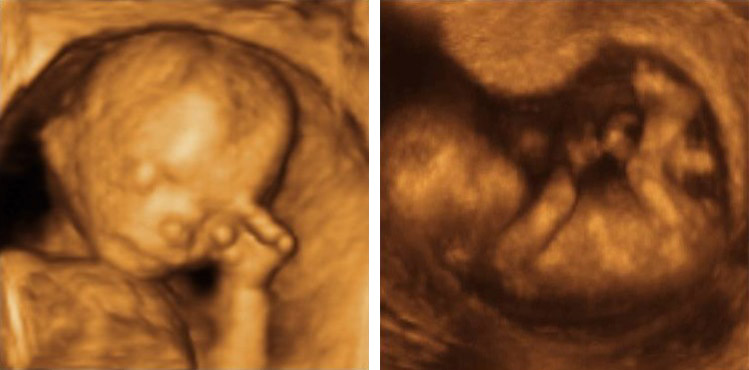Bonn: Eight out of 1000 new-born babies are born with a heart
defect. It's a blessing in disguise if the anomaly is detected before
birth and the expectant mother is transferred where necessary to a
specialist centre: if treated properly, the baby has substantially
better chances of survival, with the risk of undesirable after-effects,
e.g. resulting from lack of oxygen or poor perfusion of the organs,
being reduced. Child cardiologists at the University of Bonn are
currently developing a method whereby they can improve the detection of
heart defects even in the early stages of pregnancy.
The
object under observation is scarcely larger than a thumb nail. Three
times a second it contracts and presses a few drops of blood through the
18-week-old embryo. Fifteen centimetres of skin, fat and muscle tissue
separate it from the eye of the observer. And yet: on the computer
screen a three-dimensional image of the baby's heart pulsates which is
astonishingly accurate in its details. When Dr. Ulrike Herberg, child
cardiologist at the University of Bonn, uses the mouse to turn it in the
appropriate direction, even a layperson can recognise the cardiac
valves opening and closing.
Ultrasonic diagnostics is usually
brainwork: "Conventional equipment gives us two-dimensional images which
are cross-sections, e.g. cutting through the ventricles," Dr. Herberg
explains. What the ventricles look like spatially, whether they are
smaller than normal or perhaps are defective in the way they contract,
has to be resolved by the doctors by assembling these cross-sections in
their minds into a 3D model. "For this even with an organ which does not
move an excellent sense of space and plenty of experience are required,
and this is even more necessary with the heart, which regularly
contracts and then fills up with blood again." The best ultra-sound
specialists can thus say with more than 80% certainty whether the unborn
child is suffering from a heart defect - less experienced medical
personnel often only score a success rate of 25%.
Dr. Ulrike
Herberg is at present developing a method which is meant to facilitate
this mental exploit in conjunction with the University of Bonn's Clinic
for Obstetrics and Pre-natal Diagnostics and experts of the software
company MedCom Ltd. It involves the doctors placing a conventional
ultra-sound probe onto the pregnant patient's stomach and swivelling it
in such a way that takes in the complete heart of the unborn baby within
20 seconds. During this time the machine records about 1000 images. At
the same time it records the foetus's heartbeat with a special sensor.
This is the "baton" which tells the computer which images belong to
which "part of the beat". For example, if the baby's heart has
contracted and expanded again 60 times during the examination, the
machine has recorded a total of 60 cross-sections during its swivelling
movement at the time of maximum contraction, which are all taken from
different areas of the heart. The imaging software can now assemble a
composite 3D picture from these two-dimensional ultra-sound images. When
the probe is being swivelled for the maximum of 20 seconds the software
receives 3D pictures by this means from different phases of the
heartbeat - from complete contraction to complete relaxation. Thus the
entire movement of the myocardium can be followed on the screen. "We can
even see exactly how the cardiac valves open," Dr. Herberg enthuses,
adding: "information which is not available from the conventional
cross-sections." An additional advantage is that the three-dimensional
pictures can be turned whichever way is needed, so that the surgeon can
see the operating field on the screen and plan the therapeutic strategy
better.
Some cardiac diseases might perhaps be treated or
prevented before birth if detected early enough - "a perspective which I
find particularly attractive," Dr. Herberg declares. Thus the software
enables the volume of the heart to be calculated much more precisely
than in the past - often an early indicator that something is going
wrong in the development of the cardiac muscle. Twins, for instance, may
develop a joint cardiovascular system via the placenta. "The one twin
then keeps pumping blood into its sister's or brother's bloodstream,
thereby leading to the second twin's heart being overloaded: it becomes
excessively large, with serious heart defects being the possible
consequences." With early detection, however, this type of malformation
can be prevented by firing a laser at the joint blood vessels and
thereby sealing them.
Minor defects still need to be tackled by
the designers: the measurement of the heartbeat by the special sensor,
for examaple, can reduce the quality of the images, and the art of
swivelling the probe evenly needs practice. Once these teething troubles
are over, the method must show in clinical trials if it really is an
improvement on conventional ultra-sound diagnostics.
Contact person for the media: Dr. Ulrike Herberg, Paediatric Centre of the University of Bonn, Tel.: ++49-228-2873256, e-mail: ulrikeherberg@hotmail.com
